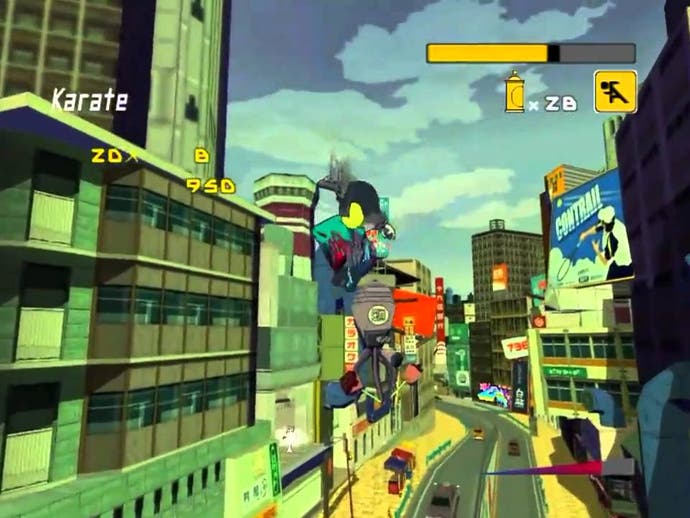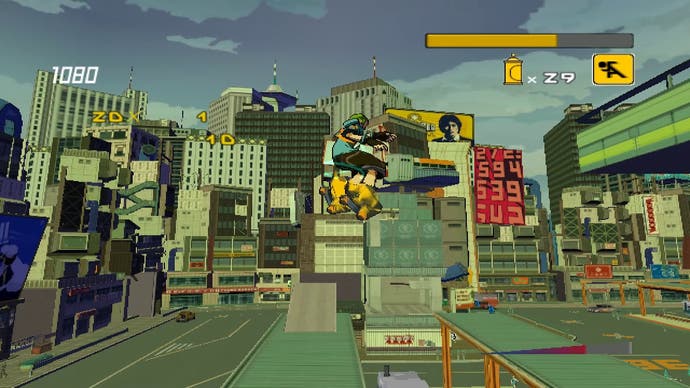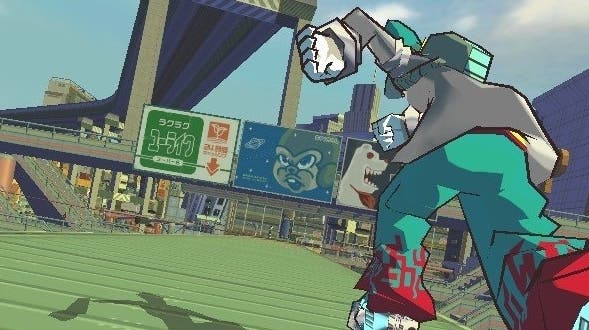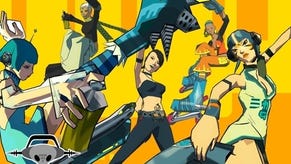What do I really love about Jet Set Radio Future?
Hitting the Rokkaku-dai Heights.
Almost two decades of playing a game, off and on, should leave you with a pretty good idea of what you love about it. But Jet Set Radio Future is different. I love it, almost beyond all other games. But the thing I love about it is so hard to grasp hold of. I do not have the words. But I want the words!
Jet Set Radio Future is a game about skating and spraypainting and doing tricks. I love all that stuff - it is dreamy and inspiring and it makes me feel elegant and in control and screw-the-man and all of that jazz. But it's not what I love most about the game. It has incredible characters and a beautiful, elbowy, constantly surprising soundtrack. I love all of that stuff too, but it's not what I love most about the game - not even Gum, I am so sorry Gum.
If I had to describe Jet Set Radio Future to a bunch of visiting aliens, I would say it's a game about movement. Your feet literally have wheels stuck to them. Standing still in this game is pretty difficult. You are meant to move forward, arms arcing out in both directions, body bent and head jutted like a prow. You are meant to look and feel a bit like a hood ornament, slicing into the wind.

And the world responds to this. This is a world built around movement. Its levels are corkscrews and loops, demanding constant forward movement, in the awareness that going forward will eventually bring you back to where you started. And its surroundings are a speedy fleeting wash of imagery and sharp angles, building fascias and advertisement hoardings, lights and passing faces. Everything about this game shouts MOVE! So what happens when you don't?
Sometimes I get a sense of what I love about Jet Set Radio Future the most in other games. Let's try this approach. There is this new class of games I am beginning to spot, often on iOS because of the touchscreen. I would call them model games, or diorama games. You have a three-dimensional model on the screen, right, and at least half the fun of the game comes from manipulating this thing, this piece of digital sculpture, turning it around with a swipe or what have you, zooming in, finding all its hidden aspects. Captain Toad is one of these kinds of games. The Get Out Kids on Apple Arcade has a touch of it. All these beautiful 3D objects, all the details crafted and put there for you to appreciate, and touch, and spin. It doesn't really matter what the game is, I think, when the stuff is this nice to look at and mess around with. Is Monument Valley a great game, or is it simply lovely to spend time with its model temples and towers, twisting them, spinning them, trying to understand their shapes?
This is the feeling I get from Jet Set Radio Future, the thing that I love the most about it - and it emerges most powerfully when I stop moving. This game's stages, its stages are like little models. I know this is true of every game to a certain extent, but with Jet Set Radio Future, I feel it so much more strongly. I am happy to skate over these places, but really what I want to do is just hold them and turn them around, look at the way they are constructed and get a sense for how they were designed. And they seem to break the design down really elegantly, too: there is the shape of something and then there is the texturing.

Rokkaku-dai Heights sums this up better than any other part of the game for me, I think. It's a forgotten shanty, a cluster of aged and neglected homes stacked on top of each other and left to the ravens. You access it through a sewer line, and when you get there it's like this little island of trash, surrounded by a wraparound horizon of over-sized, inhuman-scale industry, the stark alien globes of gas towers, the spindly rigs and chimneys of skyscrapers.
If this was a model I could hold in my hand! So much of this place is just boxes, the same shape piled and piled, set at angles. Angular walls of boxes forming canyons, forming spirals, forming a teetering tower that you can climb up, stopping at various platforms along the way.
Then you get the textures, and the boxes become something else. Wooden shacks, bits of metal awning, steel bars protruding, sun-faded advertising from yesterday, long stretches of tubeyard gravel. Everything here is that sandy brown of the ancient and rusted, the brown of train tracks where the line has closed and the forest has started to reclaim them, the brown of metal left in the sun for way too long, getting hot during the day and cold at night, changing, slowly, with each season.
I can barely remember what I did here. I think I reclaimed the place from Poison Jam, a rival skate team you meet early in the game. I think I remember a bit where a statue is knocked over, a bit where you have to open up a sort of railway shed. But mainly what I remember is exploring this place, the first actual level in Jet Set Radio Future, I think, which is all but emptied of the game's landmark crowds. I remember racing through the canyons, getting a sense of that teetering real-estate all around, stopping and understanding that it's just boxes and planes, but that it's also so much more than that, a genuine bit of video game sculpture.

And I remember the sewer line, and how Rokkaku-dai Heights connects to the rest of the city, which is somehow far more cityish for not being an open world where one spot blends into another, but by being instead a collection of different spaces that you travel between, spaces which you really can't imagine connecting in any realistic way or living alongside one another. And this makes each individual location feel more immediate. The towers loom higher, the streets seem to hold your attention more. You're not thinking so much of where you're headed or what you're going to do five minutes from now. You're thinking about where you are right now and what is possible and what this place means and how it came to be.
Different neighborhoods, each one a piece of sculpture. Shapes and textures, concrete and advertising placed upon advertising. This is a place you can't hold in your hand, so you have to hold it in your mind instead. What a thing.



